
After Srinagar, I flew to Jammu, and took the train to the modern city of Chandigarh. A little adventure on the train - couldn't book any seats so I ended up in a 2nd class chair car, sharing a long bench with about 5 other people on an overnight trip. Although uncomfortable and sleepless (I envy some Indians' ability to sleep in nearly any situation), this turned out to be one of the most incredible train rides I've had. You were forced to get to know the people around you, and everyone was so caring and bent over backwards to help each other. This young guy across from me, after putting up a little fuss for letting this poor old grandma share his extremely small sitting space, doted on her the entire trip. He would push others out of the way to give her room, and help hold her stuff. I made friends with a couple of Sikh military guys who were on some special forces in Jammu (also a heavy security area).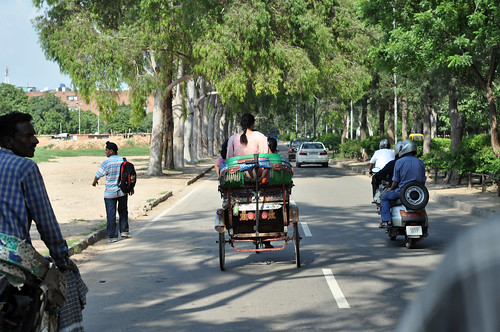
Chandigarh is a very unusual Indian city. It was planned by the French architect Le Corbusier in the 1950s as a symbol of the new, post-Independence India and has many aspects of a modern, Western city. There are wide leafy avenues, a grid system, and a lot of malls. It's a strange juxtaposition to see what would look like any major arterial road in LA, lined with trees and grassy parking strips, with bicycle rickshaws and horse-draw carriages driving around.
Le Corbusier not only designed the city, but also contributed sculptures and architected many of its major buildings. The signature piece by him is the "Open Hand" sculpture, meant to symbolize the new, open, non-corrupt Indian society (though honestly it looks like someone is saying "talk to the hand").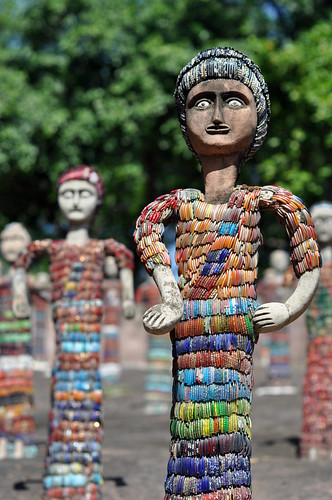
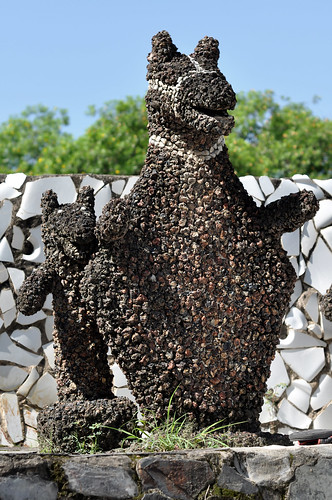
Pretty much the only thing I did in Chandigarh besides go to malls was to check out Nek Chand's Rock Garden. Chand, who was a government official, surreptitiously created the garden in his spare time, starting in 1957 and using only garbage and industrial waste. The authorities discovered it in 1975 and it's become a big attraction since then. The garden is huge, and contains thousands and thousands of sculptures of people, animals, gods, and amorphous blobs of concrete and tile. Tori, this is another place I think you would love.
Thursday, November 12, 2009
Chandigarh
Srinigar
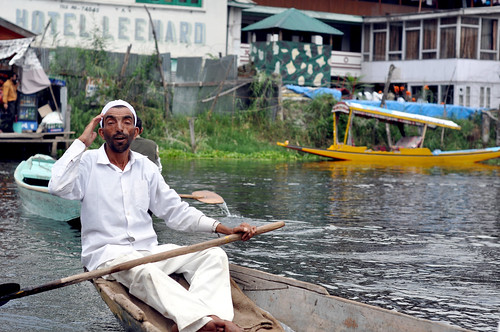
After a 19-hour bus ride, I always ask myself, "where's the angry mob to harass me?" Srinagar did not disappoint. Located in the perma-problem area of Kashmir, Srinagar has had its economy hit pretty hard by the instability, with many tourists avoiding the place due to the potential for violence (though there haven't been any attacks on tourists since the early nineties). So the locals were, um, very eager for our business when we got there. In fact, they mobbed us. As our bus arrived at the parking lot, some of them grabbed the door handles and tried to actually get in the bus. Failing that, they ran alongside the vehicle as it moved forward and parked.
The big draw in Srinagar is to get a houseboat out on Dal Lake. As we got off the bus, Erez and I found ourselves surrounded in a circle of aggressive touts trying to get us to go to their uncle's/brother's/cousin's houseboat. As you can imagine, after the long bus trip, we weren't exactly in peak condition for dealing with this. I think we kept our cool, and just said, "thanks but we are going to get a taxi and go look at houseboats ourselves," which did nothing, and lead to "please leave us alone". Eventually, the mob actually got angry with us for not engaging, and started yelling things like "Get out of Srinagar then!", which was a little creepy.
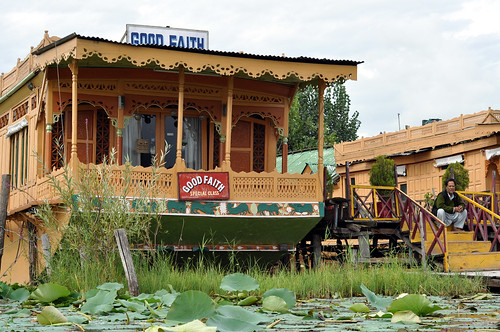
We finally made it to a taxi and of course, even he tried to get us to go see his father-in-law's houseboat! It was like in "Invasion of the Body Snatchers" when the fleeing characters finally find someone they think is still human, breath a sigh of relief, and then that person lets out the blood-curdling scream to alert the other aliens of their presence. FINE, we'll go see your father's/uncle's houseboat! So we rented a little water taxi to go see it and a few other choices, ending up taking another one.
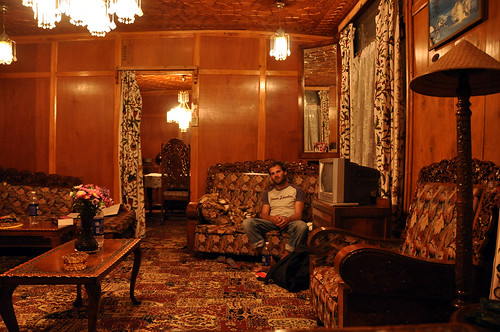
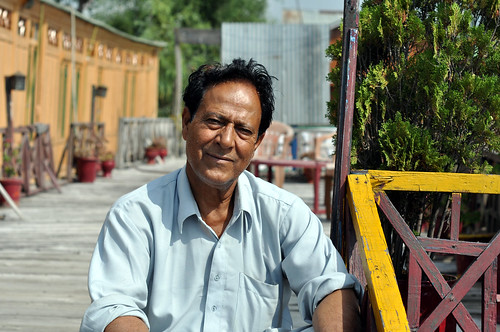
Our houseboat was sweet - kind of like an auntie's victorian drawing room on the water, and we had the whole thing to ourselves. After our warm welcome to town, we didn't really feel like going to the mainland for the rest of the trip. The man who ran it was friendly but sad, cooked us delicious meals, and evidently played a the best banjo in the area.
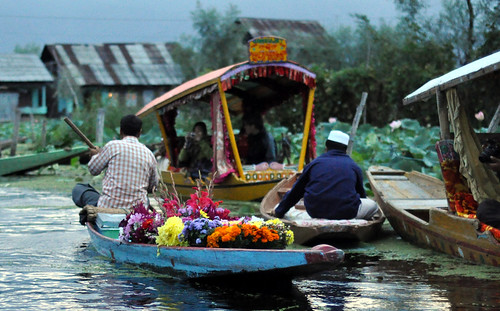

The lake is one endlessly unfolding photo opportunity, with floating markets, well-dressed ladies floating by, little boat stores pulling up to see if you need anything, and lots of channels in the reeds you can paddle through and get lost in. Erez and I spent quite a bit of time just doing that.
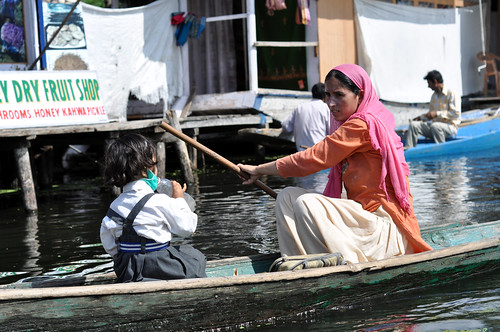
The people reminded me a bit of those in Cambodia - there is a heaviness to them you can see in their eyes, from living through a prolonged period of violence and loss. Though very friendly once you get past the aggressive sales pitch.
After a couple of relaxing days, Erez took off to go to a Vipassana meditation retreat in Delhi, and I stayed on for a little while longer (shopping mostly), eventually flying to Jammu. The Srinagar airport was one of the most locked-down security zones I've ever been to. They search the entire car, inside and out, even underneath, before you are allowed to drive up. I was security scanned a two or three times in the airport itself.
Thursday, September 24, 2009
Leh and the Dalai Lama
Wow, it's been a long time since I've been able to blog! Been in some places where the internet was slow or non-existent. Here's a brief rundown of what I've been up to in the past few months:
Leh
Leh itself reminded me a lot of Tibet - whitewashed buildings built into the sandstone hills, a huge and vibrant Buddhist culture, chortens and gompas surrounding the city. It was much more developed for tourism than I expected, with an entire section of the town devoted to rows of garden restaurants featuring all your favorite Thai and Italian dishes.
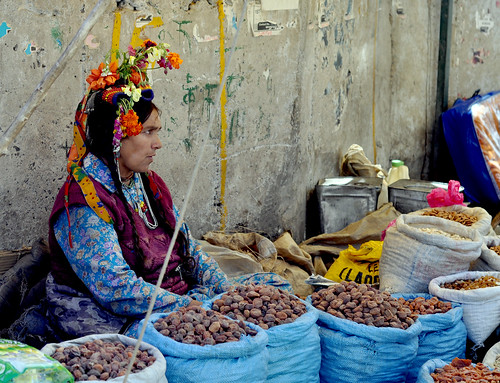
The old market still had an atmosphere of a meeting place between cultures, and you could see native Ladakhis from all over the region mixing with Tibetans and Indians. I came during the Dalai Lama teachings, so many many people appeared to be making their annual trips to town to stock up on athletic shoes and other supplies (everybody seems to like Nike, even the monks).
For a traveler, Leh is mostly a base from which you can do excursions out into Ladakh. I can't picture staying very long in the town itself. I hurried to Leh to see the Dalai Lama at the nearby Tibetan refugee colony. This was one of the most amazing experiences of my trip. There were between 20,000 and 30,000 local Ladakhis and Tibetans at the large outdoor field, all in a peaceful and joyful atmosphere.

Native Buddhism was said to have disappeared in India before the Tibetans sought refuge here in the 1950's, but that's not really true for Ladakh (it wasn't really part of India until the 20th Century). It has had a thriving Tibetan-style Buddhist culture throughout. So for the Dalai Lama to show up here is like the Pope coming - it's the biggest event of the year. Entire extended families walked or climbed aboard seriously overstuffed buses to make it out to the 4 day teaching - every day was like a huge pilgrimage.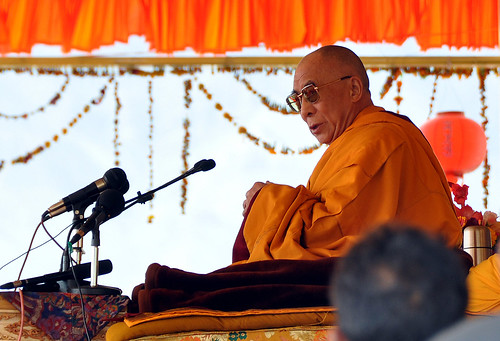
It was incredible to be able to sit in the Dalai Lama's presence for such a long period of time and hear him teach, but I found myself more amazed by the crowd I was surrounded by and the intense devotion that pervaded the place. I had some great meditations sitting on the lawn with them for hours, and met some cool Buddhists from around the world. I made friends with this guy from Israel, Erez, and we decided to do some excursions together when the teachings were over.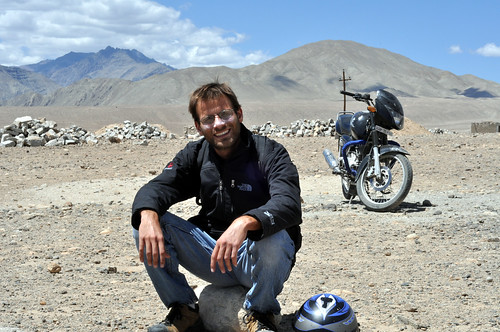
Renting bikes (and teaching Erez how to drive a motorcycle), we headed out on a series of three trips to see local monasteries, ruins and remote villages. The first day we went out to Shey Palace, an old home of the Ladakhi royal family and the incredible Tikse Monastery, me riding an Enfield for the first time (kinda like an Indian Harley - very butch).
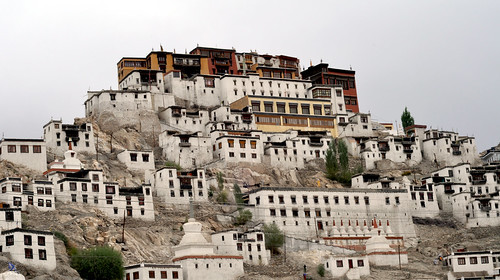
One of the highlights of Ladakh is that the Buddhist monasteries and temples are so well-preserved, having avoided the upheavals of those in Tibet. Tikse had a wonderful atmosphere about it and we were tempted to come back and stay a night at the monastery.
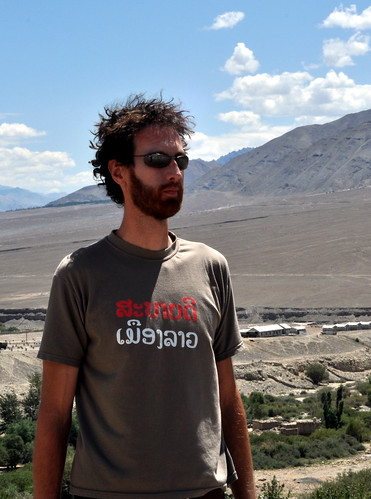
Next up was Alchi, a very old Buddhist monastery and temple, with some of the oldest and best preserved Buddhist paintings in Asia. The place itself was a bit underwhelming, but the drive out and back was spectacular - going through enormous winding valleys and flat, barren plains.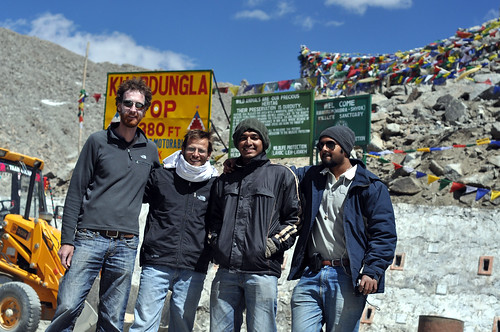

Finally we drove over the highest motorable pass in the world (which evidently is up for debate) to Nubra Valley, a little oasis in the high altitude desert served by a couple of rivers. Erez and I had an excellent time driving the bikes (though his first gear decided to stop working at the big pass and he had to push it Flintstones-like with his feet to get going into 2nd).
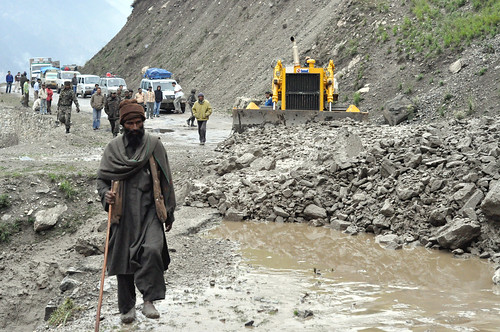
We continued to travel together out of Leh, on the 19-hour bus trip to Srinigar. People say the Manalai-Leh route is worse but I'd lay my money on this one. The roads wash out and are unpassable every winter and have this feeling of being barely patched together enough for the trucks and buses to get over them for the rest of the season. After hours of this (including another roadblocking landslide!) suddenly the scenary changes and we found ourselves in green, beautiful Kashmir. Lush and full of a surprising number of goats.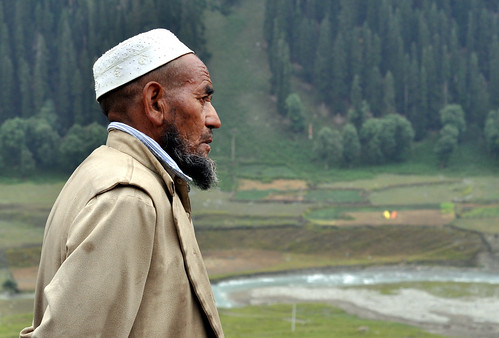
Tuesday, September 22, 2009
Manali - Leh Highway

The highway between Manali and Leh is famously bad - a 20 hour slog on pavement that is almost impossible to maintain given the punishing elements. It's closed a good part of the year for this reason. The first three hours out of Manali going over the first pass lived up to the hype. The road was so full of potholes and big stones that it felt like an amusement park ride gone terribly wrong. Another 17 hours of that would have been pretty tough, but thankfully after we got over the pass the road improved considerably. I mean, it was still 20 hours in a jeep, but other than that...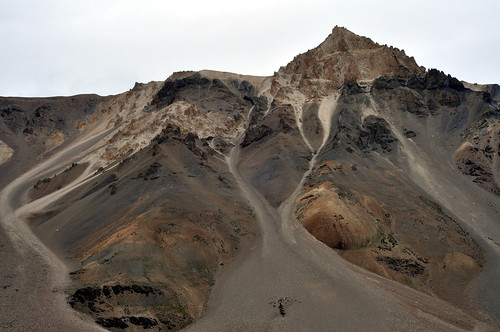
And the scenery was truly unbelievable - some of the best I have seen on my entire trip. My pictures unfortunately don't do it justice as I missed some of the fantastic parts: huge fields of fairy chimneys carved out of the rock, and enormous ornate "palaces" that looked man-made but were far too large, being slowly revealed by sand eroding away from the stronger rock underneath. The colors of the different minerals and the scrub grass made mountain-sized designs that followed the melting paths of the snow. On other hills, different sedimentary layers had been pushed around by geographic forces, and forced into wave or even swirl patterns. This landscape was similar to the Mustang area of Nepal or the Tibetan Plateau, but with more beauty and diversity.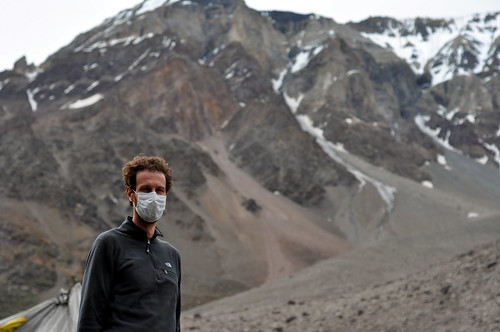
For most of the way, there were no villages at all to speak of. We stopped for meals in these little tent restaurants that had been set up on the side of the road - if you asked them where the bathroom was they just giggled and pointed to the hillside. The trip went by fine (a bit dusty perhaps - that swine flue mask the Tibetan lady gave me came in handy) until about the last hour, when some food in my stomach felt like it was planning to make an exit in any number of directions. Luckily right then a nice Belgian guy traded me his super comfy seat, and as I started to doze off my symptoms almost completely disappeared. Proving once again that most things are just in my head... 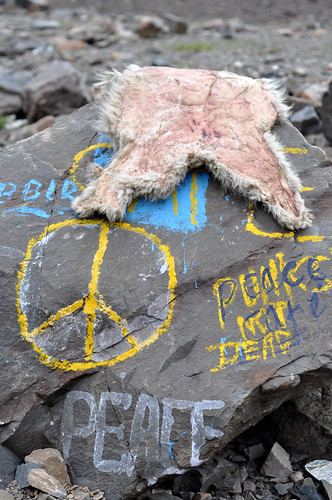
Sunday, September 13, 2009
Manali
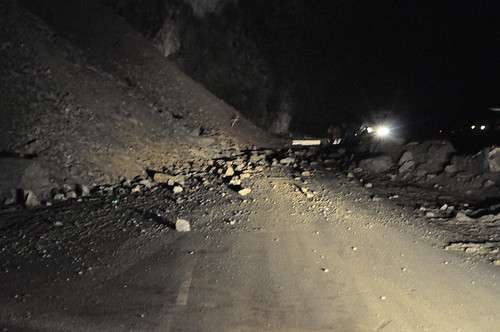
After Dharamsala I took a night bus to Manali. It's a bit of a crazy drive on a windy mountain road, and we were blocked in the middle of the night by a rockslide on the roadway. Looked liked we were going to be sleeping on the side of the road, but after about an hour and a half, enough drivers were fed up enough to start hauling the rocks away by hand. Then our driver accelerated and we drove (ye-haw Dukes of Hazzard-style) over the smaller pile of remaining rubble.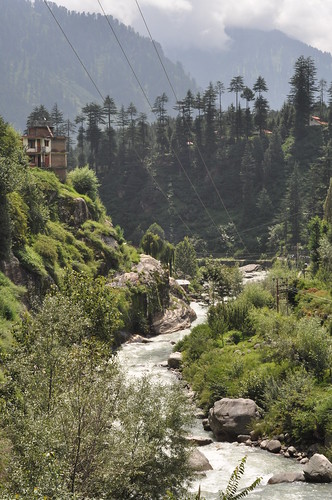
I only spent a couple of days there as I wanted to get up to Leh quickly to catch the Dalai Lama's teachings. Manali is a gorgeous area - lush, green, a few rivers flowing through, and lots of tucked away secluded guest houses. Mine was called the Rock Way and up on a cliff over one of the rivers, surrounded by gardens and fruit trees. You could totally hide out there for a week or two, reading and playing chess with the fiendishly good guest house manager. He would make a different fresh curry every night using stuff from his garden or wild mushrooms he found in the hills - delicious.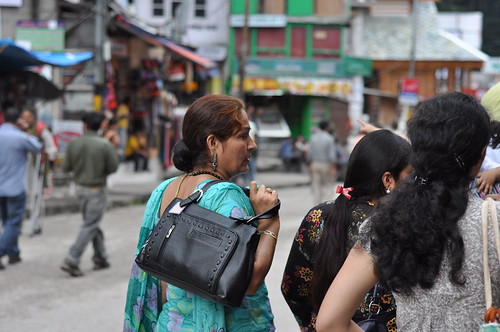
Manali also has the dubious honor of being both a big Indian middle-class tourist / honeymoon destination and a hippie backpacker hangout. It's a strange combination...
Friday, September 11, 2009
Leaving Dharamsala at last
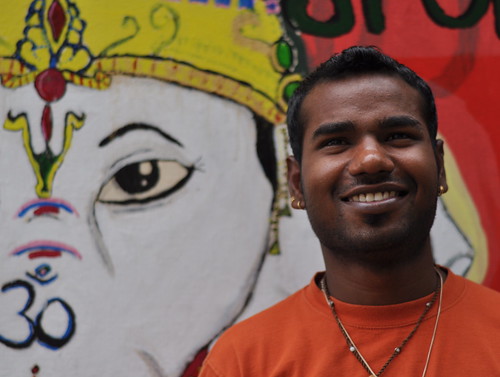
I spent about 7 weeks total in Dharamsala, during which time I kind of settled in a made myself at home. I stayed out in the quiet nearby village of Dharamkot, moving around between a few guesthouses but ending up staying at Paul House, which was run by my friend Naushad. One of the best parts about my time there was getting to spend so much time hanging out with him - he's really an amazing guy, and very focused and mature for 22 years old. I had visited him earlier in March of this year and he was just beginning to get the guest house and restaurant in shape - he had a lot of ideas for what he wanted to do to make it an inviting place to stay. Coming back it was great to see his vision become a reality. 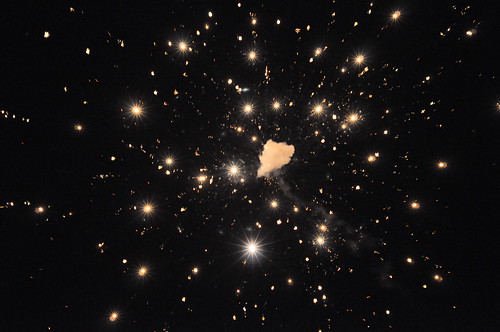
Over course of the weeks I had a lot of different experiences. I took a couple weeks of Iyengar Yoga classes, some Indian cooking classes, and did a lot of hiking in the surrounding mountains. The monsoon was in the process of coming when I was there so it was always a crap shoot whether you were going to get dumped on. But my luck was surprisingly good and I was only caught outside a couple of times during the real deluges. On the Fourth of July there were some cool Americans at Paul House, Josh and Tristan, who happened to have a fireworks fetish, so we enjoyed some crazily powerful $2.50 rockets.
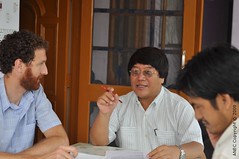
Most of the time I was there I found myself kind of unexpectedly working full time. I started volunteering at the ANEC Organization and redoing their website took a lot of time (plus I didn't really know what I was doing for a while). I even had a daily commute down the mountain into Dharamsala proper; it was an amazing walk through the forest and the central Tibetan government-in-exile buildings. The people were wonderful down there and we had a Tibetan cook come in every day to make us these great lunches. They even threw me a going away lunch with homemade momos (including sweet paneer ones).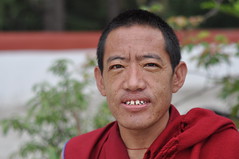

When I wasn't down at ANEC, I was hurrying off to do a series of interviews with Tibetan refugees for a documentary project. As you may or may not know, in March 2008 there was one of the biggest series of protests in Tibet since 1959. It was brutally cracked down on by the Chinese. The stories of bravery and sacrifice I heard were inspiring and of course very sad.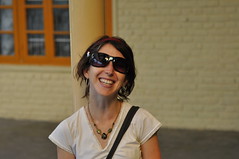

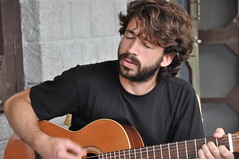

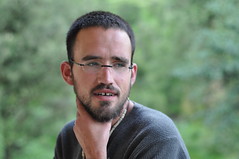
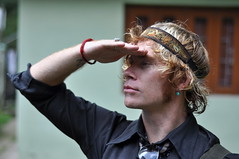
I met a ton of great people during my stay - Levinia and Ross, Josh and Tristan, the two Ilans, Leighton, Kimberly, Susie, and randomly ran into my friend Christian who I had met at a yoga retreat in Nepal. I stayed longer than pretty much everyone else (except this Australian guy who I think was running from the law - shades of Shantaram!). After my last interviews wrapped up, it was clearly time to go.
Sunday, August 2, 2009
What a good day looks like in India
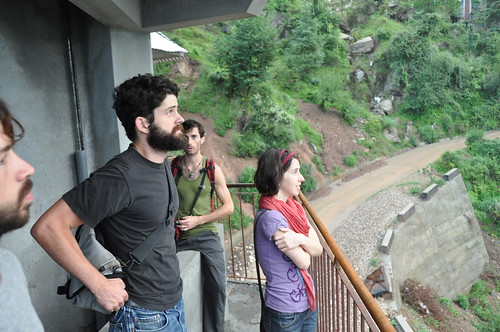
A couple of weeks ago we had a total solar eclipse in these parts (not sure how much you could see it where you are). Turned out to be one of the best days I've had in India for a long time:
A group of us (Josh, Ilan, Ross, Levinia and myself) wake up at 4:30 am in Dharamkot to hike up and see the eclipse. After some difficult pre-caffeine discussion, we decide the view would actually be worse up in the mountains as they were enclosed in clouds. Instead we head down past McLeod Ganj to try to get a clearer view out in the open. The monsoon had been coming to the area and we'd had a couple of weeks of intermittent rains. It was pretty cloudy, so our chances of seeing the eclipse appeared slim.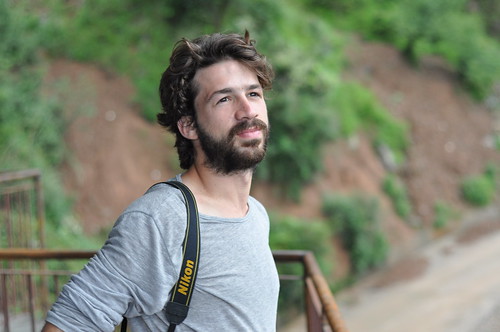
We walk out the back road from McLeod and find a nice open part with very little around - basically in the middle of nowhere. A very closed-looking tea house is the only thing around. Still cloudy. We sit on a bench and wait for things to clear. One thing you can count on around here is the weather changing quickly. Suddenly out of the blue a taxi pulls up and this slightly drunk-looking Irishman jumps out. He offers to sell us some welder's glass to look at the eclipse, which is funny because I'd just been reading about that online and wishing I had some. Still very cloudy and no eclipse in sight, I optimistically plunked down 200 rupees (enough money for a very nice dinner) to get a piece. Everyone is looking at me like "I don't know, Eric".
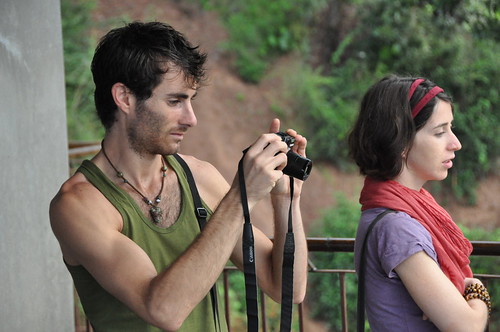
As the taxi pulled away, as if on cue the sky gets very dark and it started pouring in that monsoon-y way I've never seen before this trip. It rains so hard that umbrellas make little difference - you get soaked from the water splashing up from the ground. We look around and there is an abandoned half-finished building nearby that happens to have a great balcony on it. We hurry up there, interrupting the morning routines of the Indian construction workers who are sleeping there. They don't seem to mind at all. We hang out on the balcony to wait out the rain and take photos.
After about a half hour the rain dies down but things are still overcast. Around that time an old man comes and opens the tea house. At this point we're pretty resigned that the eclipse is not happening, so we go down to see if we can get some tea and breakfast. The tea house is like a little wood cabin with huge stacks of egg crates as the only decoration. After a lot of back and forth with the owner, we realize that aloo paratha (like a thick potato naan) and plain omelettes are the only things on the menu ("scrambled eggs?", "no", "fried eggs?", "no", "masala omelette?", "no", etc). Takes a while but by the time they come they are some of the best food I've had in a long time. Doughy eggy goodness (plus having been up for almost 4 hours didn't hurt).
We're happy sitting there eating, and forgetting all about the eclipse. Then one of us looks back out the window and says, "Hey, the sun's out!" We all look and the clouds have parted just enough to see the sun. No moon though, so we are wondering if we had missed the eclipse. Then I hold up the welders glass to the sun, and whoa, there it is! Like a magic trick. Not a total eclipse because I think we were a little late (and Dharamsala wasn't on the direct path anyway). But very cool to see.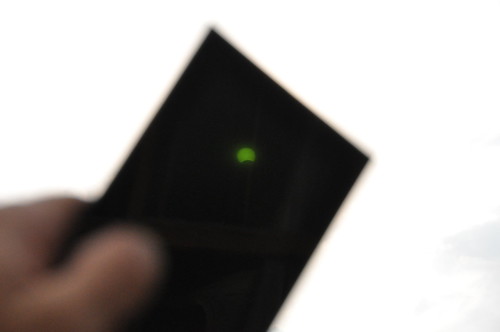
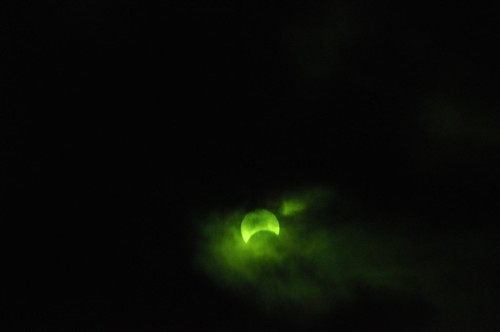
The clouds stayed away for just long enough for us to go outside, take turns with the welder's glass, and get some photos through it as well. Then, just like that, they closed back up and the sun was gone. We felt extremely lucky for those few minutes!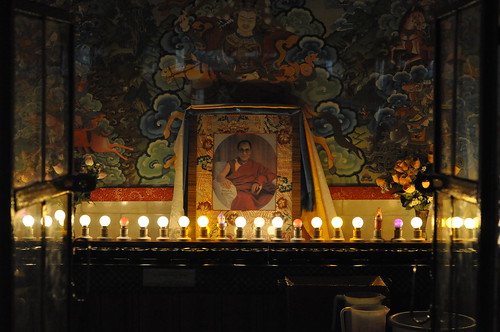
After that we hiked up the back side of the Dalai Lama's temple, and walked along the kora, or religious path. It started to drizzle again and just as the rain was really letting loose, we came to a big rain shelter with a couple of small shrines in it. We stayed out of the rain with a bunch of Tibetans who had been walking the kora as well, and after about a half hour made it the rest of the way around.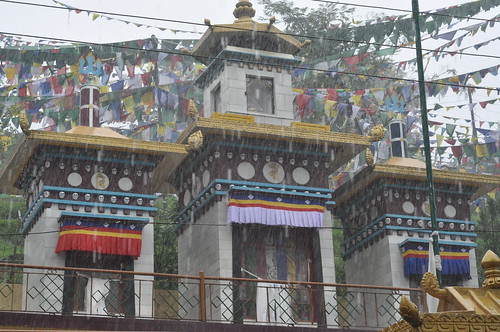
I spent the rest of the day getting a Tibetan massage (this guy really knows how to stretch out your back and neck and has helped my back pain go away), and then heading down to Dharamsala proper for my volunteering job down there. I'm working at ANEC, a non-profit which educates Tibetans on effective nonviolence resistance strategies. My main job is to redesign their website but since the power was out all afternoon, instead we had a great discussion on which strategies are appropriate for the Tibetan cause.
Later that night I saw Josh and Ilan off as they took the bus to Manali. All of us had been staying in Dharamkot for many weeks, so it was a bit sad to see them go. But we were in good spirits anyway because of our day. So that's what an excellent day in India looks like. Things rarely go as you expect them to, but somehow you end up with many beautiful moments that you are thankful for.